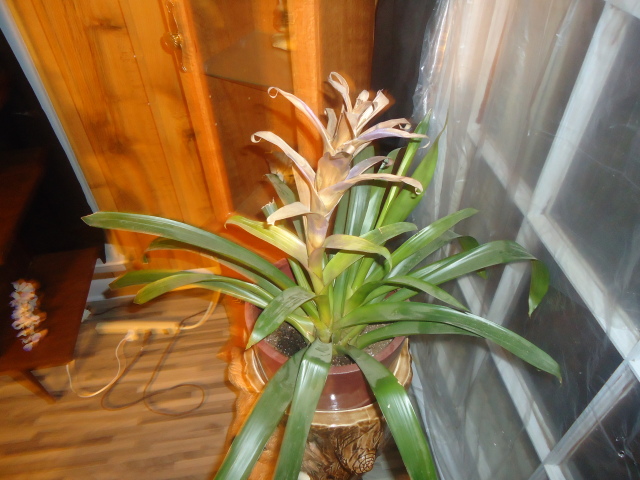Question
 My plant
My plant
We are trying to figure out why this plants looks like it is dying. When we bought it (about 6 months ago) it had a beautiful red center. We keep it watered, but it does not get direct sunlight. About a month ago the top started to turn brown but the base is still green. Should we cut the top off so new "flower" can grow? Is it in a winter state and will come back in the spring?
AnswerKimberly,
This plant will not get to looking better. It is dying. It only blooms once. It will send out side shoots, 2 or 3 babies, when the parent gets to looking really bad cut off the parent and wait for the babies to get bigger them divide them into separate pots. They will take a couple of years to grow and then they will bloom and when they are done blooming they will grow babies then die. Good luck.
Darlene
Your plant is a Guzmania bromeliad. They are wonderfully stunning tabletop plants. They feature long, narrow, shiny green leaves that rise from a deep central cup. The plants are somewhat taller than many bromeliads. Their large and showy flower bracts arise in the summer in an amazing array of colors. Guzmania are not difficult bromeliads to grow, and they will reward you with many weeks of color with little or no effort.
They like bright indirect light. Do not expose to direct sunlight. Water: Keep water in the central cup. Change water frequently with clean water to prevent rot. Avoid tap water if possible. During colder weather, they can be watered lightly in the soil, with a dry cup. Keep them at least 55篎 or higher. These are warm-house bromeliads that appreciate high humidity and warmth. Any soil mix will work with them. These are technically airplants that use their roots for support. Fertilizer very sparingly with a liquid fertilizer during the growing season.
When the flower bract dies back you can trim it back low in the cup. The mother plant will soon begin to die back, and new plantlets will begin to grow. When the new plantlets are a few inches tall, and the mother plant is looking ragged, cut the mother plant back at soil level, being careful not to damage the young offspring. These new bromeliads can be potted up individually in small pots, or left to form a clump. Make sure newly potted bromeliads are well supported梩hey have tendency to fall over as the root systems are weak at first.
Mature bromeliads should not be repotted. Smaller bromeliads can be potted into small containers until they are established, then moved into 4" or 6" pots until they flower. Be aware that a mature guzmania is a fairly top heavy plant and will tip over in a standard plastic pot. Make sure the pot is well weighted.
Although there are several varieties of guzmania in cultivation, by far the most popular in the trade are the G. lingulata and G. sanguinea. Hybridists have worked with these plants extensively, producing an amazing array of flower bract colors. The red varieties, among the most popular, include G. 'Luna,' G. 'Passion,' and many others. Guzmania are also available in multicolors, yellow, white, orange, and purple.
Guzmania are fairly typical bromeliads. The two best tips for success are these: make sure the plant is potted adequately so it won't pull over the container and provide ample warmth and humidity. If the plant is exposed to cold, dump out the central cup and refill with warmer water at the first available opportunity. These plants don't acclimate to higher light levels as well as some other bromeliads, so be extra careful about exposure to direct sunlight. As you grow babies from your original plant you can keep this going for many years but each plant will only bloom once then die. But it will always produce babies to continue. Good luck.
Darlene






